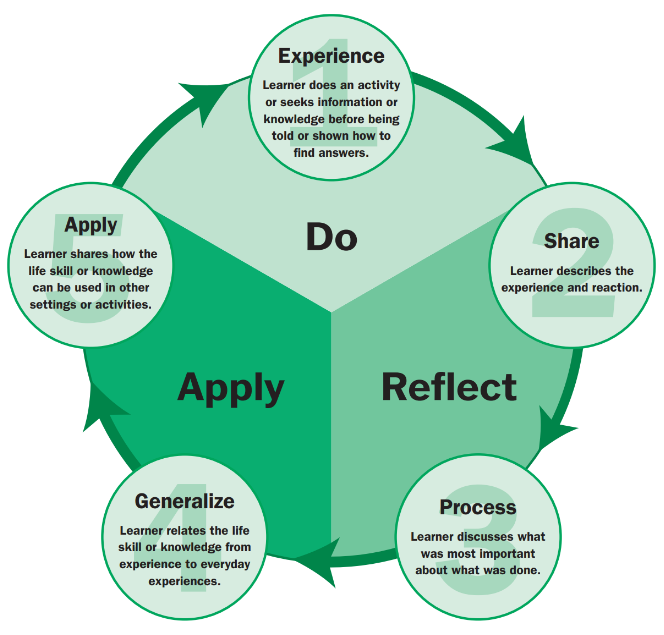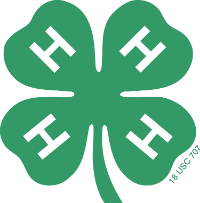Experiential Learning
Experiential Learning Model
The Experiential Learning Model is a teaching method that focuses on creating experiences for youth before intentionally processing and reflecting on those experiences at the end. The reflection portion of learning encourages young people to apply new life skills in different situations and shifts the experience from a fun activity to long-term learning and application(University of Wisconsin-Madison 2023).
Five steps are divided into three essential parts in the Experiential Learning Model: do, apply, and reflect. Each step leads naturally to the next. The process of experiential learning is a continual cycle as new skills are applied in new contexts, and as the development of more advanced skills build upon each other.
While it is helpful to work through all five steps at the end of each project area or unit, it is not required to complete each step in each project activity.

*Cooperative State Research, Education, and Extension Service (1996). Curriculum Development for Issues Programming - A Handbook for Extension Youth Development Professionals. Based on the work of Kolb, D. (1984). Experiential learning: Experience as the source of learning and development. New Jersey: Prentice-Hall.
Planning
Experiential learning may require greater preparation than an activity rooted in more traditional learning models, but greater long-term benefits make the planning time a worthwhile investment. Participants will engage in more memorable learning experiences, making the process more enjoyable and the learning longer lasting for both youth and adults.
When using the Experiential Learning Model, begin with the end in mind:
- Clarify the learning objective and learning indicators before planning an activity.
-
- What are youth meant to learn?
- Which life skill(s) are you trying to teach?
- How will youth demonstrate that they’ve learned life skills?
- Ensure the experience or activity lends itself directly to that life skill/learning objective.
- Consider reflective questions ahead of time: What developmentally appropriate questions will you ask to ensure that youth reflect on the activity and deepen their learning?
Here are some examples ofhow life skills and learning indicators relate to planned activities:
| Life Skill / Learning Objective | Success Indicator | Activity | Reflective Questions |
| Teamwork,risktaking | Sharing ideas and asking for others’ input; tryinga new approach | Play a game |
What examples of teamwork did you witness during the game? What impact did it have on your success? In what moments did you take risks during the game? How can working as a team help you in another area of your life? How do you decide when it is important to take risks? |
| Decision making, problem solving | Identifyinga problem and explaining reasoning for why their idea may help solve it | Experiments |
What decisions did you have to make while designing your experiment? What problems did you solve while designing your experiment? What factors are important to consider when determining how to solve a problem? |
| Teamwork, planning, leadership | Working with othersto plan and implement an activity | Planning a club'sserviceactivity |
How did sharing ideas make your service activity stronger? What aspects of leadership did you demonstrate while planning the service activity? What other moments have you observed in the past week that require people to work together in order to plan something? |
| Public Speaking | Clearly convey an idea in a public setting | Giving a presentation |
What did you do to ensure that you presented your ideas clearly and professionally during your presentation? When will you be able to apply these skills in the future? |
| Communication | Asking clear questions that are both pre-planned and in response to what another person shares | Conducting an interview |
What is one example of a question that you planned to ask before your interview began, and what is one example of a question that you thought to ask during the interview? Why did you decide to ask those questions? When else might it be useful for you to gather information by interviewing someone? What have you learned about others in this process? About yourself? |
Experiential Learning: Step-by-Step
Step One: DO—Experience
In the DO section of the model, youth take part in an activity that allows them to explore and practice specific life skills with minimal adult direction. Volunteers should provide guidance and facilitate as needed without providing direct instruction. The volunteer works alongside youth, encouraging them to explore and problem solve independently without telling them exactly what to do.
Step Two: REFLECT—Share
After completing the activity, youth begin to reflect on the experience. Participants start by focusing explicitly on what happened and how youth felt during the activity. Ask them to describe what happened, how they responded, and how they felt. These initial questions prepare youth to deepen their reflections in the next step of the model.
Example Share questions:
- How did you plan your (experiment, talk, project, etc.)?
- What did you learn?
- How did you feel while (completing the activity)?
- What surprised you?
- What was easiest? Most difficult?
- What did you do?
- Where did you go?
- What was your goal?
- What changes did you make?
- What challenges did you face?
Step Three: REFLECT—Process
This step encourages youth to reflect on the process of the activity, highlighting how the activity was completed. Youth identify the most important steps and aspects of the activity, which will allow them to more easily generalize their learning in the next step.
Example Process questions:
- What steps did you take to complete the activity?
- What problems did you encounter along the way?
- How did you solve these problems?
- Why is this skill important?
- What is important about (the activity topic, life skill, etc.)?

Step Four: APPLY—Generalize
In this step, the focus shifts from the activity to the life skill(s). The questions delve into what the youth personally learned from this experience. This discussion prepares youth to transfer their learning to other situations.
Example Generalize questions:
- What did you learn about (life skill) during this activity?
- How does this relate to other things you have been learning?
- What are some similar experiences you have had with (life skill)?
Step Five: APPLY —Apply
Finally, youth apply what they have learned to their everyday lives. Discuss ways they could use this learning in other situations or change how they approach certain tasks in the future. Ensure the focus is on applying the knowledge and skills rather than simply understanding the activity's subject matter.
Example Apply questions:
- How does this activity relate to your everyday life?
- What have you learned about yourself? About others?
- How will you act differently as a result?
General Suggestions:
Remember that debriefing and discussing experience moves youth from simply completing an activity to learning from it. The reflective portion at the end of the Experiential Learning Model allows youth to integrate their learning into other areas of their lives and provides closure. Prioritize 5-12 minutes at the end of the session to complete Reflect and Apply portions, prepare intentional questions to ask in advance, and listen carefully to youths’ responses.
When leading group discussions:
- Use “Think, Pair, Share”: Form pairs or groups of three youth to discuss a question. Have youth consider their responses independently before sharing their thoughts with their partner or small group. Then have several youth share with the group at large.
- Use “Turn and Talk”: Pairs or groups of three turn to each other to discuss the questions right away before sharing with the group at large.
- Guide group thinking by providing sentence prompts to complete in response to questions (e.g., “I learned that…” or “I felt…”). Sentence prompts are especially helpful for younger learners and language learners.
- Adjust questions based on responses to previous questions.
- Encourage participants to build on their experiences. Help them identify opportunities to practice new skills.
University of Wisconsin-Madison (2023). Experiential learning model. Wisconsin 4-H division of extension. https://4h.extension.wisc.edu/resources/volunteer-resources/4-h-foundations/experiential-learning-model/
Adapted from University of Wisconsin-Madison. (2023). Experiential learning model handout. Wisconsin 4-H division of extension. https://4h.extension.wisc.edu/resources/volunteer-resources/4-h-foundations/experiential-learning-model/

View the printable PDF version of this Experiential Learning webpage.

